Clematis Solidarity - growing rules
Clematis Solidarity is a fairly new variety, bred in 2004 by Polish breeders. A year later, the plant received worldwide recognition, marked with a silver medal at the Plantarium 2005 prize. It differs from its liana-like counterparts in its original rich colors and small size, due to which it is widely in demand among amateur gardeners and designers.

Clematis solidarity photo and description
Description of the variety
Clematis solidarnosc is a compact perennial with climbing shoots. In height, it reaches no more than 1.6 m. In a young state, the branches are painted in a light green shade, as they grow, they acquire a tree-like structure.
Vegetative processes are densely covered with smooth, light green leaf plates. The leaves are medium in size. Complex in shape, they consist of 3 segments with a jagged edge.
The plant belongs to the number of dioecious plants, in the flowering stage it forms large buds of rich red color with a paler stripe in the middle. There are also specimens with small light specks. The surface of the petals is velvety with a characteristic oblong ribbing.
The root system is fibrous, and therefore it is allowed to periodically transplant the vine, which allows you to observe crop rotation and change the design of the garden.
Landing features
When planting this variety, it is worth considering its moderate speed of plant development and a suspension in growth upon reaching adulthood. In the future, the shrub begins to fill the side space.
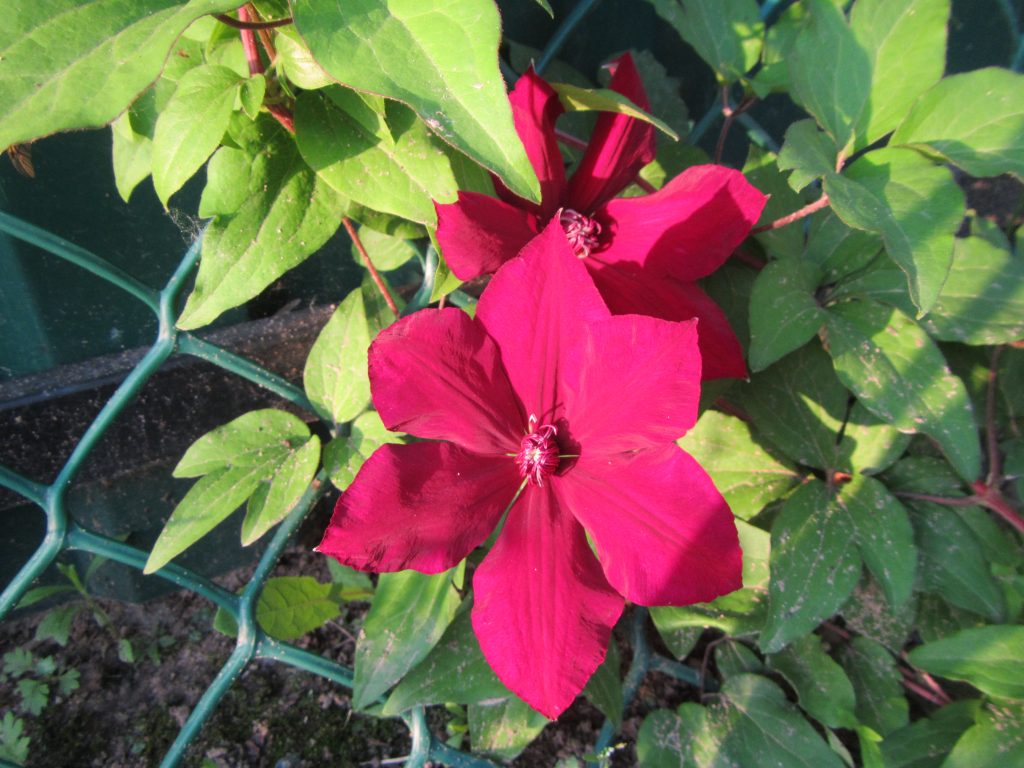
Clematis solidarnosc
To grow lianas, the installation of a support is a necessary requirement. When the trellis should be comfortable enough for the subsequent removal of the lashes from it.
Timing
A prerequisite for planting a plant is the absence of the threat of frost. The optimal timing for the procedure, taking into account the use of seedlings with an open root system, is considered April and the first days of May, while the early growing season of the flower should be taken into account. With a deviation from the norm, the life cycle of the culture changes, which has a detrimental effect on its survival rate.
There are no such restrictions for seedlings with closed roots; they can be planted not only in spring, but also in autumn or summer.
Seat selection
It is not recommended to place plants close to buildings; in such conditions, excessive heating of the green mass is observed, and the gardener is faced with the problem of removing the vine from the support. When placing, it is necessary to take into account the light-requiring of the shrub, while the root system should be in shade.
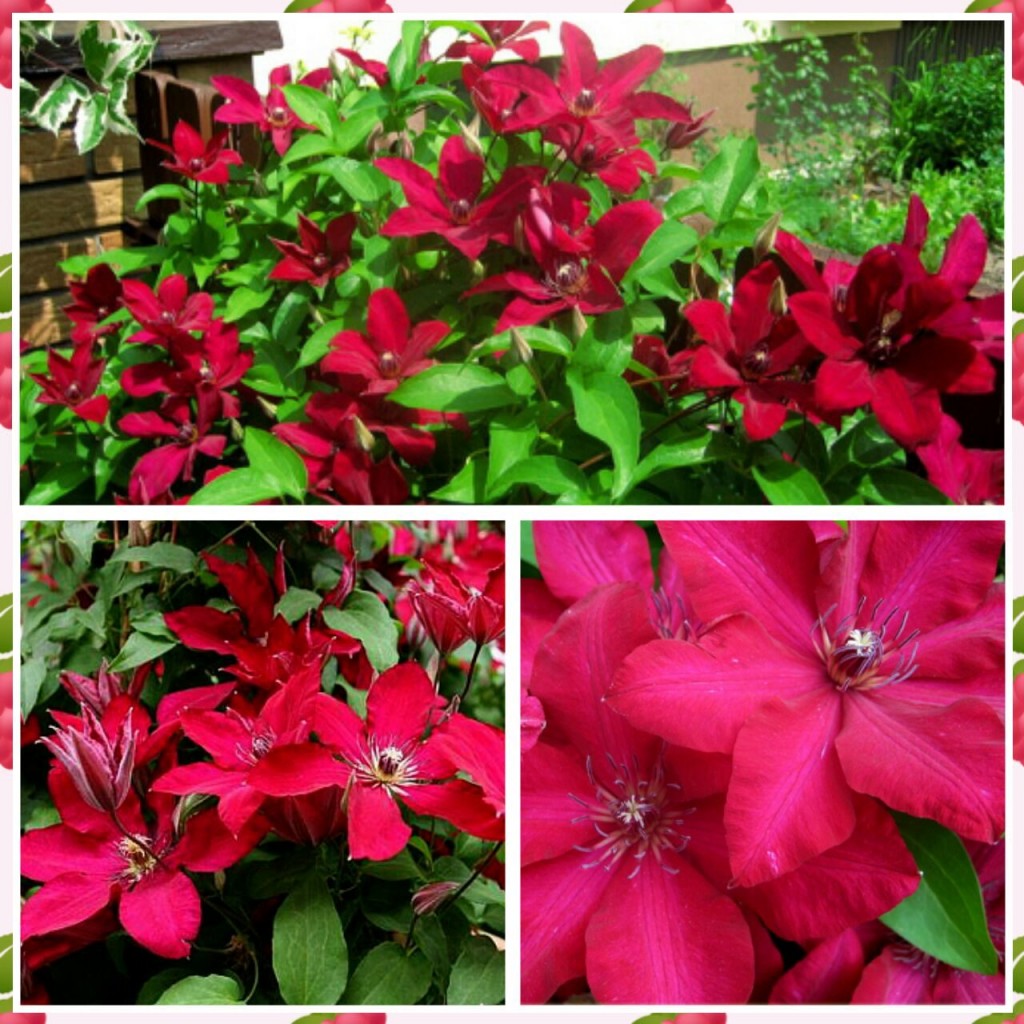
Clematis solidarity description
Areas exposed to drafts will not work. Especially young plants are injured by sudden gusts of wind. A desirable condition for comfortable growth is deep groundwater.If the garden is located in a low area, care should be taken to establish a moisture drainage system.
An important role for the culture is played by the composition of the soil mixture, for which they combine:
- river sand - 3 kg;
- vegetable humus - 5 kg;
- peat soil - 3 kg;
- wood ash - 200 g;
- nitrophosphate - 200 g;
- superphosphate - 100 g.
The planting hole is prepared 10 days before the appointed date - a drainage layer is laid out on the bottom and half covered with a substrate.
Seed preparation
Before planting, the seedlings are recommended to be kept at a temperature of 0-2 ° C, in case of bud germination, they should be transferred to a cooler room with good lighting. This will prevent the plant from pulling out.
The root system is first treated with an antifungal agent, then kept in a growth biostimulator.
Landing technology
- They dig a hole 0.6 * 0.6 * 0.6 m in size, lay a drainage pillow 10 cm thick at the bottom.When several plants are planted, a step of 0.7 m is maintained.
- Part of the prepared substrate is poured in, a seedling is placed, the roots are carefully straightened. At the same time, a support is installed - if the trellis is placed at the end of the procedure, the risk of damaging the rhizome of the culture increases.
- The remaining space of the hole is filled, deepening the neck by 7 cm.When an adult plant is moved to a new place, the depth is increased to 15 cm.
- The topsoil is compacted. Watered with organic matter.
Care
Watering
This variety, like all Clematis, loves moisture. However, excessive waterlogging should not be allowed. Regular overdrying of the upper layer will also adversely affect development.
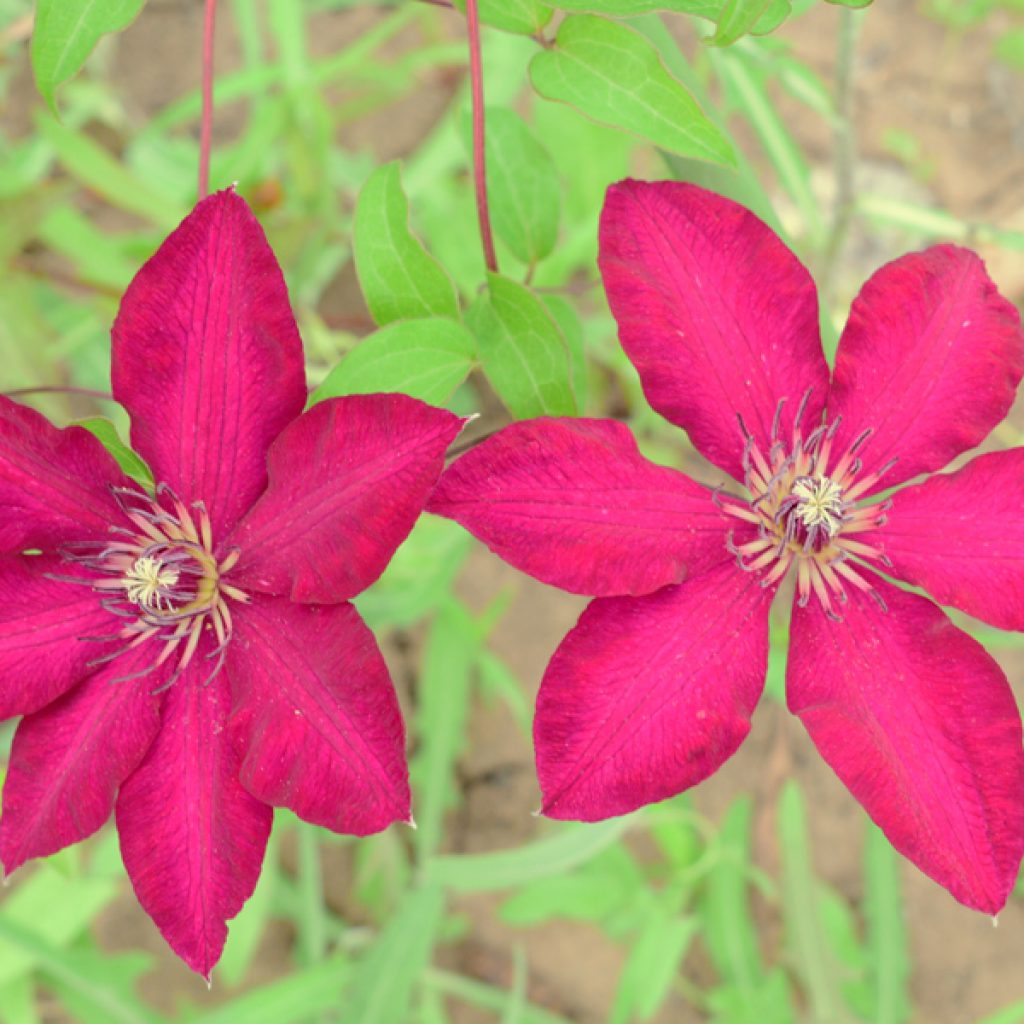
Clematis solidarity photo
Adult specimens are watered every 2 weeks with plenty of water, young ones - as needed, taking into account precipitation. In a particularly dry summer, irrigation is allowed up to 4 times in 7 days.
Top dressing
Solidarity needs regular feeding, which is carried out several times per season:
- in early spring (in early May) - with urea;
- at the budding stage - Agricola-7;
- at the end of flowering - with organic fertilizers;
- in the fall - superphosphate and preparations with potassium included in the composition.
Additionally, in spring, the plant is watered with milk of lime (200 g of lime per 10 liters of water) to stimulate the growing season.
Mulching and loosening
Loosening the soil near the bushes allows you to normalize the aeration of the substrate and prevent mold. Also, during the procedure, which should be carried out after moistening the surface, weeds are removed, which inhibits the growth of the culture.
Clematis is mulched in order to minimize moisture evaporation and the appearance of weeds, as well as protect the root system from overheating and freezing in the cold season.
Trimming group
The variety of clematis Solidarity belongs to the 2nd pruning group, however, it is recommended to shorten all branches to the lower 3 pairs of buds in the first year after planting. Thanks to such a correction, the plant will get stronger and take root more quickly, and in the future it will bush better.
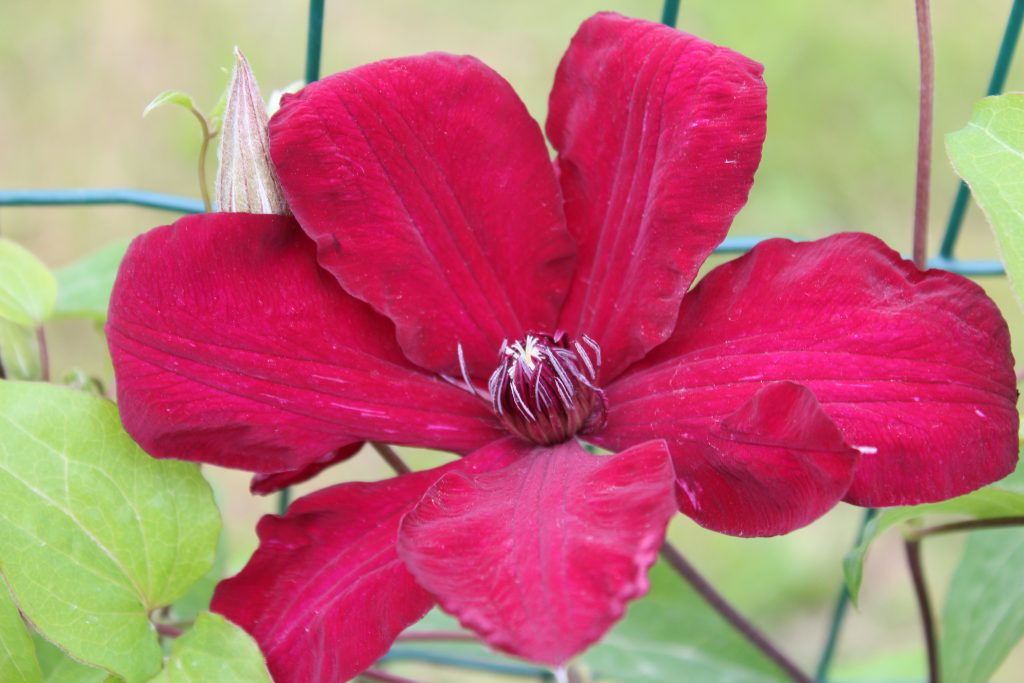
Variety of clematis solidarity
A haircut is carried out in the fall after the completion of the leaf fall and the removal of the liana from the support:
- Perennial shoots are stopped by 15-20 cm.
- Underdeveloped segments are cut off.
- Eliminate that part of the crown that has dried up over the summer.
Preparing for winter
This variety requires shelter for the winter, regardless of the climatic conditions of the region.
- The bush is watered abundantly.
- Pruning is done.
- The shoots remaining after the correction are twisted into a ring.
- The branches are placed on a pillow of fallen leaves. Cover with a layer of mulch.
- Garden arches are installed over the plant, on which the film is stretched. For greater protection, they cover it with spruce branches, and in winter they cover it with snow.
Reproduction
Seeds
The method is used extremely rarely due to the fact that the plants begin to bloom only after a few years, and the procedure itself takes a fairly long period of time.
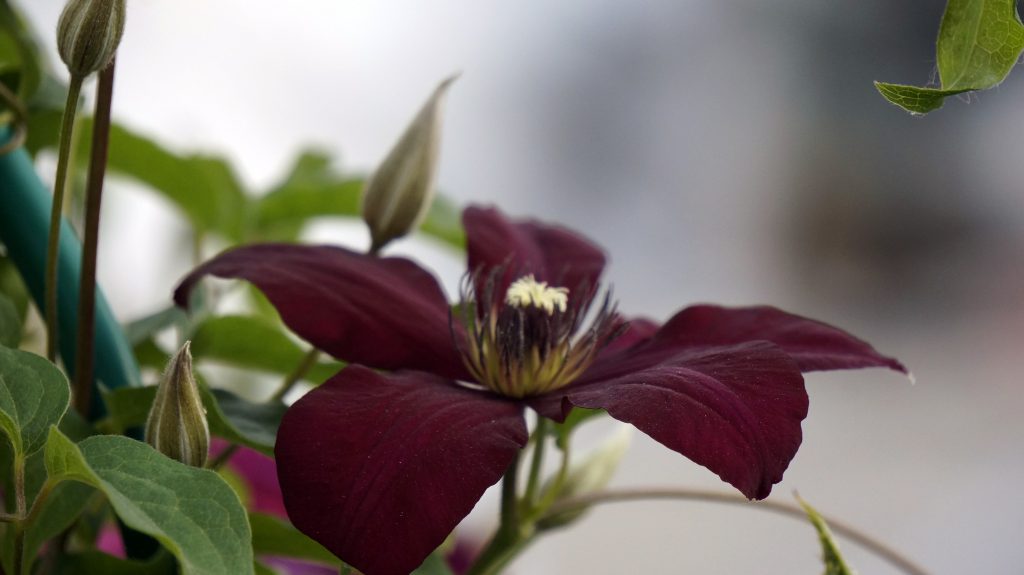
Clematis solidarity reviews
It is recommended to collect seeds as soon as clematis has bloomed, because the best germination is observed in specimens obtained in the current year. The seeds are large in size, and therefore germinate unevenly and slowly. On average, the process of growing seedlings takes up to 8 months.
The seed is buried in a moist soil mixture, consisting of equal parts of peat, leafy earth and sand to a depth exceeding it in diameter by 2 times. To accelerate germination, it is preliminarily placed in water for 10 days, while the liquid should be changed every 4 days.
They contain seedlings at a temperature of 20-25 degrees, watering is carried out through a pallet. At stage 2, these leaves are dived into separate containers, planted in open ground after 2-3 years.
Layers
It is recommended to propagate clematis by layering in the fall. For this, in October, strong shoots are chosen, from which all the foliage is removed and up to 3 buds are cut off. Then they dig it into a shallow trench and sprinkle it with a layer of peat. Additionally, cover with spruce branches.
In the spring, the shelter is removed, the plant is watered abundantly. The seedling is moved to a new place in the fall, carefully separating it from the mother bush, subject to the appearance of a young growth.
Rhizome division
This breeding method is allowed only for young shrubs, not exceeding 6 years of age. Otherwise, the risk of injury to the root system increases, which grows quickly enough.
The procedure is carried out in the spring before the beginning of the growing season. In the course of it, the plant is dug up, the roots are slightly shaken off from the substrate. After that, they are divided into plots with a sharp pruner so that each has a healthy neck and several growth buds.
Diseases and pests
| Name | Signs | Prophylaxis | Treatment |
| Nematode | The plant lags behind in development, the leaves curl in hot weather. Convex growths form on the roots. | Marigolds or calendula are planted nearby. Wormwood / mint is used as a material for mulch. Periodically fertilize with complexes with the included ammonia (ammonium sulfate, ammonium nitrate). | Chemicals: chloropicrin, lindane, karbofos, phosphamide. Systemic drugs: Nematofagin BT, Basamil, Pecilomycin, Phytochit, Carbation, Nemagon. |
| Wilt | Brown tint between the veins on the lower leaves, loss of turgor, suspension of growth. The leaves begin to fall off, the shoots bend into an arc, dark blotches are noticeable when cut. | Do not exceed the recommended rate of nitrogen-containing fertilizers. In the process of loosening the soil, injury to the roots is avoided. | Purchased preparations: Agate, trichodermine (twice a season with an interval of 2 weeks), copper sulfate at a concentration of 1% (in spring and autumn). |
| Powdery mildew | White spots with a cotton-like bloom, as the disease progresses, they grow and cover the entire surface of the leaf. | Do not allow waterlogging of the soil, watered with infusion on hay dust or cow's milk. | Folk methods: soda ash solution (40 g per 10 l of water). Purchased funds: Fitosporin-M, Baktofit, Apirin-B. |
| Gray rot | Grayish dust on the surface of predominantly young leaves and shoots. Loss of firmness and characteristic color. At the last stage, mold is present. | They regularly loosen the soil, avoid thickening of the crown and crowding of plantings. Observe the watering regime. | In the initial phase: copper sulfate (1 tsp), chalk (1 glass), wood ash (1 glass) are diluted in 10 liters of water. In case of severe damage: Fitosporin-M, Bordeaux liquid (1%), Gamair, Fundazol. |
| Rust | Red pads on the underside of the leaf | Trees with a dense crown are planted around the perimeter of the site. Weeds and damaged segments are removed in time. | Avakos, Akanto Plus, Alkor Super, Alpari, Antlant. |
| Aphid | Sticky film and punctures on the surface. The leaves are deformed, dry out. | The plant is regularly examined, birds are attracted to the garden, the affected parts are disposed of, and weeding is carried out in a timely manner. Anthills are destroyed. | Folk remedies: infusion of tobacco, hot pepper. Purchased drugs: Confidor, Fitoverm, Iskra, Decis. |
| Spider mite | Thin white cobweb on the underside of leaf plates, light dots, dry leaves. | Weeds are regularly removed, plant residues are disposed of, sprayed with garlic infusion. | Iskra-Bio, Tiovit-Jet, Fitoverm, Fufanon-Nova, Kleschevit. |
| Slugs, snails | Edged edges. Visible on visual inspection. | They regularly mow the grass throughout the site, observe the recommended interval between plantings. | In the evening, traps are set from glasses with a small amount of beer / syrup / fermented compote, in the morning they collect and destroy the slugs caught on the bait. Purchased drugs: Bitoxibacillin, Inta-Ts-M, Kinmiks, Predator. |
Use in landscape design
Clematis Solidarity is a spectacular plant with rich scarlet flowers; it is in great demand among gardeners as a decoration of a personal plot.
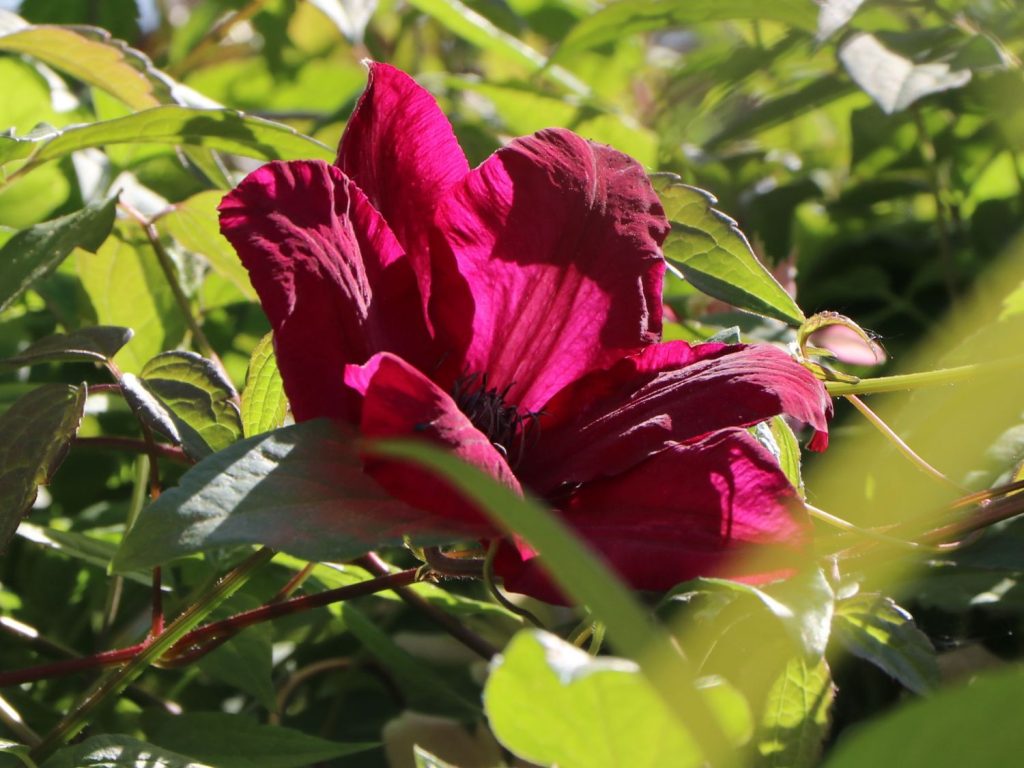
Clematis varieties solidarity
It is used in several modifications:
- It is most often used as an element of vertical gardening. When constructing a support made of wire or twine, it can easily decorate an unpresentable facade of a building or a fence. Taking into account its compact dimensions, it can be placed along the railing on the terrace or gazebo.
- Planting in bulk containers is allowed, which allows you to grow large-flowered liana even on a balcony or loggia.
- The culture goes well with deciduous shrubs, such as viburnum or spirea, as well as with other decorative flowers - a rose or panicle hydrangea.
Testimonials
Before buying Clematis Solidarity, some gardeners have doubts, believing that the crop belonging to the 2nd pruning group is characterized by high maintenance requirements. However, practice shows completely different results. An important factor in positive reviews about the variety is its high decorative effect.
Liana forms buds early enough, while it is in this stage until October. During flowering, it forms a dense crimson carpet that stands out against the background of the entire exterior of the garden.

